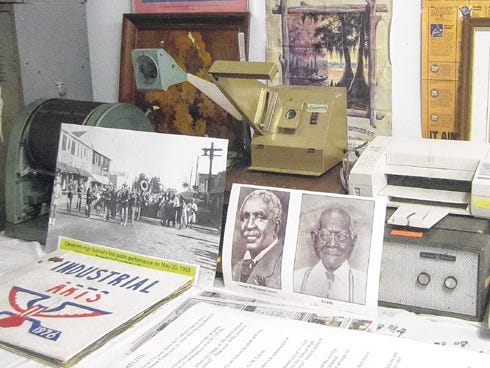
CRESTVIEW — Segregated education produced the 1954 opening of Carver-Hill School, then a state-of-the art place of learning for black students.
Today, Carver-Hill Museum in Allen Park celebrates the spirit of community that the school engendered.
One Tuesday morning, Rae Roberson, a museum volunteer and member of the Carver-Hill Memorial and Historical Society, which operates the museum, showed a trio of visitors around the facility.
Rather than a Smithsonian in which artifacts are carefully curated, Carver- Hill Museum is a repository of Crestview pride.
As one visitor praised the collection and the museum for preserving it, Roberson said, “That’s what I tell you: we relay, relate and remember here.”
Carver-Hill School closed in 1969 when Okaloosa County integrated its schools. Many mementoes that migrated to the museum’s collection included a collection of 1960s school equipment.
“Welcome to the world of non-digital,” reads a sign near the devices.
Carver-Hill Panthers cheerleader megaphones mingle beside old filmstrip projectors and mimeograph machines. Diplomas and scrapbooks share shelf space with overhead projectors.
Typewriters, adding machines and Dictaphones are on display in the center of the room above bins of treasured documents and archives preserving the city’s black heritage.
Special artifacts The museum’s north side is devoted to local black residents’ service in the U.S. military. On another wall is a cracked and worn 1925 diploma from Tuskegee Normal and Industrial Institute. It was earned by Roberson’s uncle, Claiborne Payne “C.P.” Randolph.
He lived in campus housing down the hall from George Washington Carver, one of the school, museum and historical society’s namesakes.
“He was my uncle, he was my grandpa, he was everything to me,” Roberson said as she proudly gazed at the diploma. “You wouldn’t believe it, but he died in my arms.”
Some posters and photos that cover the walls hold special meaning for Roberson.
One shows the Carver- Hill Panthers band parading down Main Street on May 20, 1955. “That was the school’s first band,” Roberson said. “We walked downtown and we got all the attention. They opened up the street for us and we showed up and paraded.”
A collection of band uniforms, hall lockers and the school’s original bell remind Roberson of the lessons she and hundreds of other students learned in its classrooms.
The three R’s — reading,’riting and ’rithmetic — were just part of their education. There was also a P.
“I learned from Carver- Hill that you’ve got pride,” Roberson said.
Contact News Bulletin Staff Writer Brian Hughes at 850-682-6524 or brianh@crestviewbulletin.com. Follow him on Twitter @cnbBrian.
This article originally appeared on Crestview News Bulletin: Carver-Hill Museum celebrates Crestview’s black heritage
